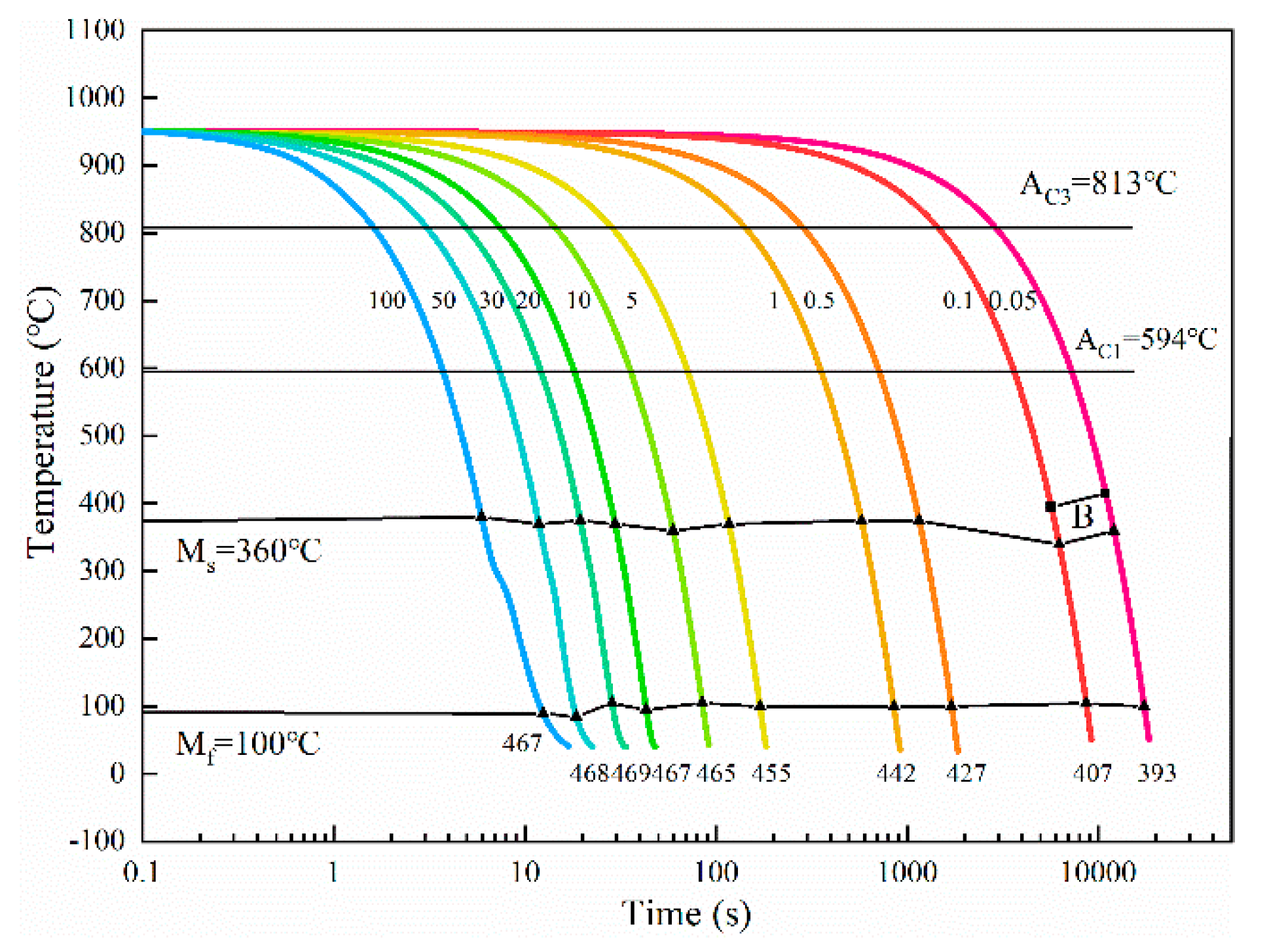Effect of the Deformation Degree on the Microstructure Evolution of an Austenite Reverted Transformation-Annealed Medium Manganese Steel
Abstract
:1. Introduction
2. Materials and Methods
3. Results and Discussion
4. Conclusions
Author Contributions
Funding
Acknowledgments
Conflicts of Interest
References
- Qu, S.P.; Zhang, Y.C.; Pang, X.; Gao, K.G. Influence of temperature field on the microstructure of low carbon microalloyed ferrite–bainite dual-phase steel during heat treatment. Mater. Sci. Eng. A 2012, 536, 136–142. [Google Scholar] [CrossRef]
- Zhang, S.J.; Liu, X.H.; Liu, L.Z. A tensile specimen of tailor rolled blanks with equal probability in yield and its mechanical behavior analysis. Materials (Basel) 2019, 11, 693. [Google Scholar] [CrossRef] [PubMed] [Green Version]
- Peng, Y.; Liu, C.Y.; Hao, L.H.; Xing, P.D. Review of performance gradient distribution hot forming technology. Chin. J. Mech. Eng. (Chin. Ed.) 2016, 52, 67–75. [Google Scholar] [CrossRef]
- Shafiei, E.; Dehghani, K. Effects of thickness ratio and length of thickness transition zone on the tensile behavior of tailor rolled blanks. Trans. Indian. Inst. Met. 2018, 71, 1211–1222. [Google Scholar] [CrossRef]
- Kong, L.; Liu, C.Y.; Peng, Y. Study on variable gradient characteristics hot stamping under non-uniform temperature field. Chin. J. Mech. Eng. (Chin. Ed.) 2017, 53, 75–81. [Google Scholar] [CrossRef]
- Mandana, Z.S.; Silvia, B.; Andrea, G.; Davide, M.; Carlo, M. Impact of warm rolling process parameters on crystallographic textures, microstructure and mechanical properties of low-carbon boron-bearing steels. Metals 2018, 8, 927. [Google Scholar]
- Speer, J.; Matlock, D.K.; De Cooman, B.C.; Schroth, J.G. Carbon partitioning into austenite after martensite transformation. Acta Mater. 2003, 51, 2611–2622. [Google Scholar] [CrossRef]
- Giuliano, A.; Dario, R.; Marcin, G.; Stefano, M.; Franco, Z. The role of microstructure on tensile plastic behavior of ductile iron GJS 400 produced through different cooling rates, Part I: Microstructure. Metals 2019, 9, 1282. [Google Scholar]
- Gerdemann, F.L.H.; Speer, J.G.; Matlock, D.K. Microstructure and hardness of steel grade 9260 heat-treated by the quenching and partitioning (Q & P) process. Mater. Sci. Technol. 2004, 1, 439–449. [Google Scholar]
- Wang, X.D.; Zhong, N.; Rong, Y.H.; Hsu, T.Y.; Wang, L. Novel ultrahigh-strength nanolath martensitic steel by quenching–partitioning–tempering process. J. Mater. Res. 2009, 24, 260–267. [Google Scholar] [CrossRef]
- Yi, H.L.; Chen, P.; Hou, Z.Y.; Hong, N.; Cai, H.L.; Xu, Y.B.; Wu, D.; Wang, G.D. A novel design: Partitioning achieved by quenching and tempering (Q–T & P) in an aluminium-added low-density steel. Scr. Mater. 2013, 68, 370–374. [Google Scholar]
- Fan, L.; Wang, T.L.; Fu, Z.B.; Zhang, S.M.; Wang, Q.F. Effect of heat-treatment on-line process temperature on the microstructure and tensile properties of a low carbon Nb-microalloyed steel. Mater. Sci. Eng. A 2014, 607, 559–568. [Google Scholar] [CrossRef]
- Huang, L.; Deng, X.T.; Liu, J.; Wang, Z.D. Relationship between retained austenite stability and cryogenic impact toughness in 0.12C-3.0Mn low carbon medium manganese steel. Acta Metall. Sin. 2016, 53, 316–324. [Google Scholar]
- Kim, J.I.; Syn, C.K.; Morris, J.W. Microstructural sources of toughness in QLT-Treated 5.5Ni cryogenic steel. Metall. Trans. A 1983, 14, 93–103. [Google Scholar] [CrossRef]
- Frommeyer, G.; Brux, U.; Neumann, P. Supra-ductile and high-strength manganese-TRIP/TWIP steels for high energy absorption purposes. ISIJ Int. 2003, 43, 438–446. [Google Scholar] [CrossRef] [Green Version]
- Gan, G.P.; Ye, J.; Fan, L. Effect of tempering treatment on microstructure and low temperature toughness of a low carbon bainite steel. J. Iron Steel Res. Int. 2020, 3, 258–264. [Google Scholar]
- Niikura, M.; Morris, J.W. Thermal processing of ferritic 5Mn steel for toughness at cryogenic temperatures. Mater. Sci. Eng. A 1980, 11, 1531–1540. [Google Scholar] [CrossRef]
- Dong, H.; Cao, W.Q.; Shi, J.; Wang, C.Y.; Wang, M.Q.; Weng, Y.Q. Microstructure and performance control technology of the 3rd generation auto sheet steels. Iron Steel 2011, 46, 1–11. [Google Scholar]
- Mueller, J.J.; Matlock, D.K.; Speer, J.G.; De Moor, E. Accelerated ferrite-to-austenite transformation during intercritical annealing of medium-manganese steels due to cold-rolling. Metals 2019, 9, 926. [Google Scholar] [CrossRef] [Green Version]
- Gibbs, P.J.; De Cooman, B.C.; Brown, D.W.; Clausen, B.; Schroth, J.G.; Merwin, M.J.; Matlock, D.K. Strain partitioning in ultra-fine grained medium-manganese transformation induced plasticity steel. Mater. Sci. Eng. A 2014, 609, 323–333. [Google Scholar] [CrossRef]
- Aydin, H.; Essadiqi, E.; Jung, I.H.; Yue, S. Development of 3rd generation AHSS with medium Mn content alloying compositions. Mater. Sci. Eng. A 2013, 564, 501–508. [Google Scholar] [CrossRef]
- Zhou, T.P.; Chen, Z.J.; Cao, W.Q. Microstructure evolution and mechanical properties of ART-annealed medium manganese steel (0.15C-5Mn-Al) processed by cold rolling. Chin. J. Mech. Eng. (Chin. Ed.) 2017, 53, 134–139. [Google Scholar] [CrossRef]







| Element | C | Mn | Si | Mo | Nb | V | P | S |
|---|---|---|---|---|---|---|---|---|
| wt.% | 0.17 | 4.9 | 1.17 | 0.07 | 0.09 | 0.08 | 0.01 | 0.008 |
© 2020 by the authors. Licensee MDPI, Basel, Switzerland. This article is an open access article distributed under the terms and conditions of the Creative Commons Attribution (CC BY) license (http://creativecommons.org/licenses/by/4.0/).
Share and Cite
Liu, C.; Peng, Y.; Kong, L.; Wang, Y. Effect of the Deformation Degree on the Microstructure Evolution of an Austenite Reverted Transformation-Annealed Medium Manganese Steel. Metals 2020, 10, 887. https://doi.org/10.3390/met10070887
Liu C, Peng Y, Kong L, Wang Y. Effect of the Deformation Degree on the Microstructure Evolution of an Austenite Reverted Transformation-Annealed Medium Manganese Steel. Metals. 2020; 10(7):887. https://doi.org/10.3390/met10070887
Chicago/Turabian StyleLiu, Caiyi, Yan Peng, Ling Kong, and Yanqiang Wang. 2020. "Effect of the Deformation Degree on the Microstructure Evolution of an Austenite Reverted Transformation-Annealed Medium Manganese Steel" Metals 10, no. 7: 887. https://doi.org/10.3390/met10070887




